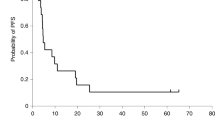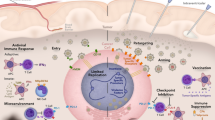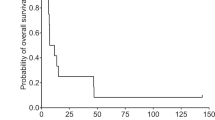Abstract
Novel methods of local control for sarcomas are needed. We investigated the antitumor effect of two related herpes simplex virus (HSV) mutants, NV1020 and NV1066, on human rhabdomyosracoma cells and xenografts. Cell death correlated with virus replication and apoptosis in cultured cells and tumors. Complete regression was seen in all tumors <250 mm3 following a single injection, yet only half of tumors >250 mm3 showed a complete response. Fractionation of the virus dose into five injection sites did not increase transduction efficiency, transgene expression, or virus production, but did yield more widespread intratumoral distribution. Despite the same total dose of virus, improved control of large tumors was seen using fractionated injections as all large tumors (500–700 mm3) had durable, complete regression. Our data suggest that oncolytic HSVs may be useful for local control of bulky rhabdomyosarcoma tumors and that fractionated virus administration results in a more widespread virus infection and better tumor control. Therefore, strategies to maximize intratumoral virus distribution at initial delivery should be sought.
This is a preview of subscription content, access via your institution
Access options
Subscribe to this journal
Receive 12 print issues and online access
$259.00 per year
only $21.58 per issue
Buy this article
- Purchase on Springer Link
- Instant access to full article PDF
Prices may be subject to local taxes which are calculated during checkout






Similar content being viewed by others
References
Trovik C, Bauer H, Alvegard T, et al. Surgical margins, local recurrence and metastasis in soft tissue sarcomas: 559 surgically-treated patients from the Scandinavian Sarcoma Group Register. Eur J Cancer. 2000;36:710–716.
Matsumoto S, Ahmed A, Kawaguchi N, Manabe J, Matsushita Y . Results of surgery for malignant fibrous histiocytomas of soft tissue. Int J Clin Oncol. 2003;8:104–109.
Sarcoma meta-analysis collaboration. Adjuvant chemotherapy for localised resectable soft-tissue sarcoma of adults: meta-analysis of individual data. Lancet. 1997;350:1647–1654.
Weitz J, Antonescu C, Brennan M . Localized extremity soft tissue sarcoma: improved knowledge with unchanged survival over time. J Clin Oncol. 2003;21:2719–2725.
Borden E, Baker L, Bell R, et al. Soft tissue sarcomas of adults: State of the translational science. Clin Cancer Res. 2003;9:1941–1956.
Pratt C, Maurer H, Gieser P, et al. Treatment of unresectable or metastatic pediatric soft tissue sarcomas with surgery, irradiation, and chemotherapy: a Pediatric Oncology Group study. Med Pediatr Oncol. 1998;30:201–209.
Spunt S, Hill D, Motosue A, et al. Clinical features and outcome of initially unresected nonmetastatic pediatric nonrhabdomyosarcoma soft tissue sarcoma. J Clin Oncol. 2002;20:3225–3235.
Ferrari A, Casanova M, Bisogno G, et al. Rhabdomyosarcoma in infants younger than one year old. Cancer. 2003;97:2597–2604.
Heyn R, Raney Jr R, Hays DM, et al. Late effects of therapy in patients with paratesticular rhabdomyosarcoma. Intergroup Rhabdomyosarcoma Study Committee. J Clin Oncol. 1992;10:614–623.
Raney B, Tefft M, Heyn R, et al. Ascending myelitis after intensive chemotherapy and radiation therapy in children with cranial parameningeal sarcoma. Cancer. 1992;69:1498–1506.
Heyn R, Haeberlen V, Newton WA, et al. Second malignant neoplasms in children treated for rhabdomyosarcoma. Intergroup Rhabdomyosarcoma Study Committee. J Clin Oncol. 1993;11:262–270.
Heyn R, Khan F, Ensign LG, et al. Acute myeloid leukemia in patients treated for rhabdomyosarcoma with cyclophosphamide and low-dose etoposide on Intergroup Rhabdomyosarcoma Study III: an interim report. Med Pediatr Oncol. 1994;23:99–106.
Markert JM, Medlock MD, Rabkin SD, et al. Conditionally replicating herpes simplex virus mutant, G207 for the treatment of malignant glioma: results of a phase I trial. Gene Ther. 2000;7:867–874.
Rampling R, Cruickshank G, Papanastassiou V, et al. Toxicity evaluation of replication-competent herpes simplex virus (ICP 34.5 null mutant 1716) in patients with recurrent malignant glioma. Gene Ther. 2000;7:859–866.
Fong Y, Kemeny N, Jarnagin W, et al. Phase 1 study of a replication-competent herpes simplex oncolytic virus for treatment of hepatic colorectal metastases. Prog/Proc Am Soc Clin Oncol. 2002;21:8a (abstract #27).
Bharatan N, Currier M, Cripe T . Differential susceptibility of pediatric sarcoma cells to oncolysis by conditionally replication-competent herpes simplex viruses. J Ped Hem Onc. 2001;24:447–453.
Cinatl Jr J, Cinatl J, Michaelis M, et al. Potent oncolytic activity of multimutated herpes simplex virus G207 in combination with vincristine against human rhabdomyosarcoma. Cancer Res. 2003;63:1508–1514.
Varghese S, Rabkin S . Oncolytic herpes simplex virus vectors for cancer virotherapy. Cancer Gene Ther. 2002;9:967–978.
Arceci R, Cripe T . Emerging cancer-targeted therapies. Pediatr Clin N Am. 2002;49:1339–1368.
Meignier B, Longnecker R, Roizman B . In vivo behavior of genetically engineered herpes simplex viruses R7017 and R7020: construction and evaluation in rodents. J Infect Dis. 1988;158:602–614.
Wong RJ, Joe JK, Kim SH, Shah JP, Horsburgh B, Fong Y . Oncolytic herpesvirus effectively treats murine squamous cell carcinoma and spreads by natural lymphatics to treat sites of lymphatic metastases. Hum Gene Ther. 2002;13: 1213–1223.
Farassati F, Yang A-D, Lee P . Oncogenes in ras signalling pathway dictate host-cell permissiveness to herpes simplex virus 1. Nat Cell Biol. 2001;3:745–750.
Galvan V, Roizman B . Herpes simplex virus 1 induces and blocks apoptosis at multiple steps during infection and protects cells from exogenous inducers in a cell type-dependent manner. Proc Natl Acad Sci USA. 1998;95: 3931–3936.
Aubert M, Blaho J . Modulation of apoptosis during herpes simplex virus infection in human cells. Microbes Infect. 2001;3:859–866.
Aubert M, Blaho J . Viral oncoapoptosis of human tumor cells. Gene Ther. 2003;10:1437–1445.
Stanziale SF, Petrowsky H, Adusumilli PS, Ben-Porat L, Gonen M, Fong Y . Infection with oncolytic herpes simplex virus-1 induces apoptosis in neighboring human cancer cells: a potential target to increase anticancer activity. Clin Cancer Res. 2004;10:3225–3232.
Jia W, McDermott M, Goldie J, Cynader M, Tan J, Tufaro F . Selective destruction of gliomas in immunocompetent rats by thymidine kinase-defective herpes simplex virus type 1. J Nat Cancer Inst. 1994;86:1209–1215.
Chambers R, Gillespie G, Soroceanu L, et al. Comparison of genetically engineered herpes simplex viruses for the treatment of brain tumors in a scid mouse model of human malignant glioma. Proc Natl Acad Sci USA. 1995;92: 1411–1415.
Andreansky S, He B, Gillespie Y, et al. The application of genetically engineered herpes simplex viruses to the treatment of experimental brain tumors. Proc Natl Acad Sci USA. 1996;93:11313–11318.
Ebright M, Zager J, Malhotra S, et al. Replication-competent herpes virus NV1020 as direct treatment of pleural cancer in a rat model. J Thorac Cardiovasc Surg. 2002;124:123–129.
Coukos G, Makrigiannakis A, Kank E, et al. Use of carrier cells to deliver a replication-selective Herpes simplex virus-1 mutant for the intraperitoneal therapy of epithelial ovarian cancer. Clin Can Res. 1999;5:1523–1537.
Coukos G, Makrigiannakis A, Kang EH, Rubin SC, Albelda SM, Molnar-Kimber KL . Oncolytic herpes simplex virus-1 lacking ICP34.5 induces p53-independent death and is efficacious against chemotherapy-resistant ovarian cancer. Clin Cancer Res. 2000;6:3342–3353.
Miller C, Fraser N . Role of the immune response during neuro-attenuated herpes simplex virus-mediated tumor destruction in a muring intracranial melanoma model. Cancer Res. 2000;60:5714–5722.
Toda M, Rabkin SD, Martuza RL . Treatment of human breast cancer in a brain metastatic model by G207, a replication-competent multimutated herpes simplex virus 1. Hum Gene Ther. 1998;9:2177–2185.
Toda M, Rabkin SD, Kojima H, Martuza RL . Herpes simplex virus as an in situ cancer vaccine for the induction of specific anti-tumor immunity. Hum Gene Ther. 1999;10: 385–393.
Carew JF, Kooby DA, Halterman MW, Federoff HJ, Fong Y . Selective infection and cytolysis of human head and neck squamous cell carcinoma with sparing of normal mucosa by a cytotoxic herpes simplex virus type 1 (G207). Hum Gene Ther. 1999;10:1599–1606.
Walker JR, McGeagh KG, Sundaresan P, Jorgensen TJ, Rabkin SD, Martuza RL . Local and systemic therapy of human prostate adenocarcinoma with the conditionally replicating herpes simplex virus vector G207. Hum Gene Ther. 1999;10:2237–2243.
Todo T, Rabkin SD, Chahlavi A, Martuza RL . Corticosteroid administration does not affect viral oncolytic activity, but inhibits antitumor immunity in replication-competent herpes simplex virus tumor therapy. Hum Gene Ther. 1999;10:2869–2878.
Todo T, Rabkin SD, Sundaresan P, et al. Systemic antitumor immunity in experimental brain tumor therapy using a multimutated, replication-competent herpes simplex virus. Hum Gene Ther. 1999;10:2741–2755.
Todo T, Feigenbaum F, Rabkin SD, et al. Viral shedding and biodistribution of G207, a multimutated, conditionally replicating herpes simplex virus type 1, after intracerebral inoculation in aotus. Mol Ther. 2000;2:588–595.
Oyama M, Ohigashi T, Hoshi M, et al. Intravesical and intravenous therapy of human bladder cancer by the herpes vector G207. Hum Gene Ther. 2000;11:1683–1693.
Todo T, Martuza R, Dallman M, Rabkin S . In situ expression of soluble B7-1 in the context of oncolytic herpes simplex virus induces potent antitumor immunity. Cancer Res. 2001;61:153–161.
Wong RJ, Kim SH, Joe JK, Shah JP, Johnson PA, Fong Y . Effective treatment of head and neck squamous cell carcinoma by an oncolytic herpes simplex virus. J Am Coll Surg. 2001;193:12–21.
Nakano K, Todo T, Chijiiwa K, Tanaka M . Therapeutic efficacy of G207, a conditionally replicating herpes simplex virus type 1 mutant, for gallbladder carcinoma in immunocompetent hamsters. Mol Ther. 2001;3:431–437.
Liu B, Robinson M, Han Z-Q, et al. ICP34.5 deleted herpes simplex virus with enhanced oncolytic, immune stimulating, and anti-tumour proporties. Gene Ther. 2003;10:292–303.
Yamamura H, Hashio M, Noguchi M, et al. Identification of the transcriptional regulatory sequences of human calponin promoter and their use in targeting a conditionally replicating herpes vector to malignant human soft tissue and bone tumors. Cancer Res. 2001;61:3969–3977.
Ichikawa T, Petros W, Ludeman S, et al. Intraneoplastic polymer-based delivery of cyclophosphamide for intratumoral bioconversion by a replicating oncolytic viral vector. Cancer Res. 2001;61:864–868.
Wang-Wuu S, Soukup S, Ballard E, Gotwals B, Lampkin B . Chromosomal analysis of sixteen human rhabdomyosarcomas. Cancer Res. 1988;48:983–987.
Wein L, Wu J, Kirn D . Validation and analysis of a mathematical model of a replication-competent oncolytic virus for cancer treatment: Implications for virus design and delivery. Cancer Res. 2003;63:1317–1324.
Bennett J, Delman K, Burt B, et al. Comparison of safety, delivery, and efficacy of two oncolytic herpes viruses (G207 and NV1020) for peritoneal cancer. Cancer Gene Ther. 2002;9:935–945.
Stanziale SF, Petrowsky H, Joe JK, et al. Ionizing radiation potentiates the antitumor efficacy of oncolytic herpes simplex virus G207 by upregulating ribonucleotide reductase. Surgery. 2002;132:353–359.
Massuda E, Dunphy E, Redman R, et al. Regulated expression of the diphtheria toxin A chain by a tumor-specific chimeric transcription factor results in selective toxicity for alveolar rhabdomyosarcoma cells. Proc Nat Acad Sci USA. 1997;94:14701–14706.
Mineta T, Rabkin SD, Yazaki T, Hunter WD, Martuza RL . Attenuated multi-mutated herpes simplex virus-1 for the treatment of malignant gliomas. Nat Med. 1995;1:938–943.
Acknowledgements
We thank Frank Tufaro, Brian Horsburgh, and MediGene, Inc. for providing virus; James Wells and Marie-Dominique Filippi for help with fluorescence microscopy, Michelle Sudheimer and Rebecca Haas for technical assistance; and Nancy Sawtell for rabbit skin cells and advice. This work was supported by grants from the Foundation for the Children's Oncology Group (Chair's Developmental Fund), the Cincinnati Children's Hospital Translational Research Initiative, TeeOffAgainstCancer.org, an American Medical Association Foundation Seed Grant to YYM, and by the American Cancer Society Research Scholar Grant #RSG-02-254-01-MGO to TPC.
Author information
Authors and Affiliations
Corresponding author
Rights and permissions
About this article
Cite this article
Currier, M., Adams, L., Mahller, Y. et al. Widespread intratumoral virus distribution with fractionated injection enables local control of large human rhabdomyosarcoma xenografts by oncolytic herpes simplex viruses. Cancer Gene Ther 12, 407–416 (2005). https://doi.org/10.1038/sj.cgt.7700799
Received:
Published:
Issue Date:
DOI: https://doi.org/10.1038/sj.cgt.7700799
Keywords
This article is cited by
-
Improving therapeutic efficacy of IL-12 intratumoral gene electrotransfer through novel plasmid design and modified parameters
Gene Therapy (2018)
-
Pediatric cancer gone viral. Part II: potential clinical application of oncolytic herpes simplex virus-1 in children
Molecular Therapy - Oncolytics (2015)
-
Oncolytic HSV virotherapy in murine sarcomas differentially triggers an antitumor T-cell response in the absence of virus permissivity
Molecular Therapy - Oncolytics (2014)
-
The role of cyclophosphamide in enhancing antitumor efficacy of an adenovirus oncolytic vector in subcutaneous Syrian hamster tumors
Cancer Gene Therapy (2013)
-
VEGF Blockade Enables Oncolytic Cancer Virotherapy in Part by Modulating Intratumoral Myeloid Cells
Molecular Therapy (2013)



